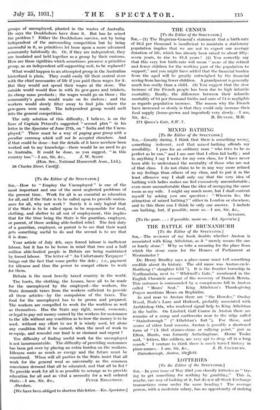THE BATTLE OF BRUNANBURH [To the Editor of the SPECTATOR.]
SIR,—The reviewer of my book doubts whether Anston is associated with King Athelstan, as it " merely means the one or lonely stone." Why so trite a meaning for the place from which the stone came for the Houses of Parliament at Westminster ?
Dr. Henry Bradley says a place-name must tell something credible about its history. The old name was Anstan-en-le- Mortheng (" slaughter field "). It is the frontier township in Northumbria, next to " Gate," mentioned in the English Chronicle account of the recovery of Danish Mercia. This entrance is commanded by a conspicuous hill in Anston called " Moses' Scat." King Athelstan's Thanksgiving Prayer mentions Moses on Rephidim.
In and near to Anstan there arc " the Howdes," Owday Wood, Hode's Lane and Hodsock, probably associated with Archbishop Oda, who rendered signal help to King Athelstan in the battle. On Lindricic Golf Course in Anston there arc remains of a camp and earthworks near to the ridge called " Stainsborough " (" Athelstan's fort "). For these, and scores of other local reasons, Anstan is possibly a shortened form of " (A thel st)anes-stane or rallying point," just as Elton, Hunts, was formerly Aethelingtune. Horne Tooke said, " letters, like soldiers, are very apt to drop off in a long march." I venture to think there is much buried history in place-names.—I am, Sir, &e., J. H. Cockatrax. Stainsborough, Anston, Sheffield.










































 Previous page
Previous page